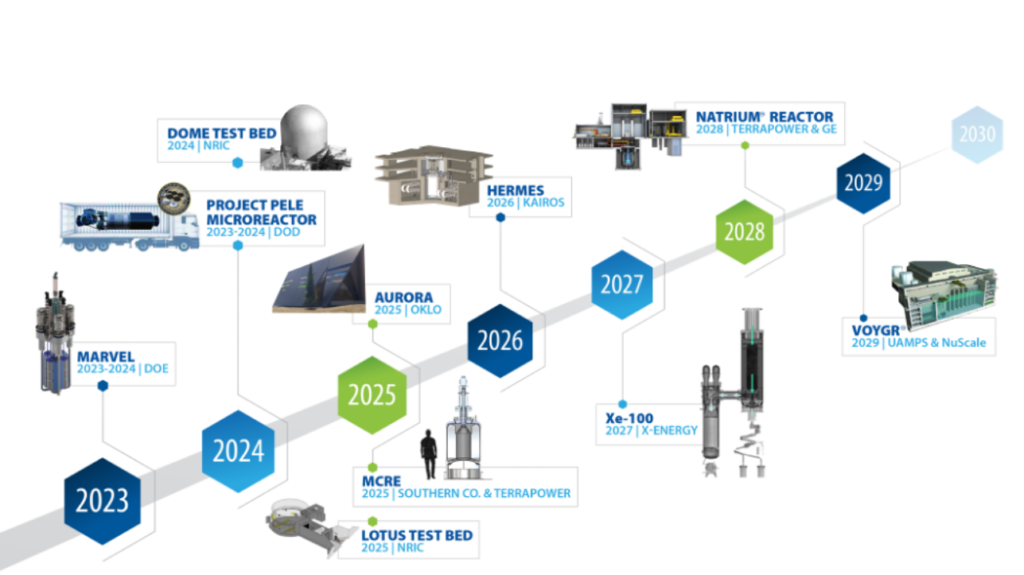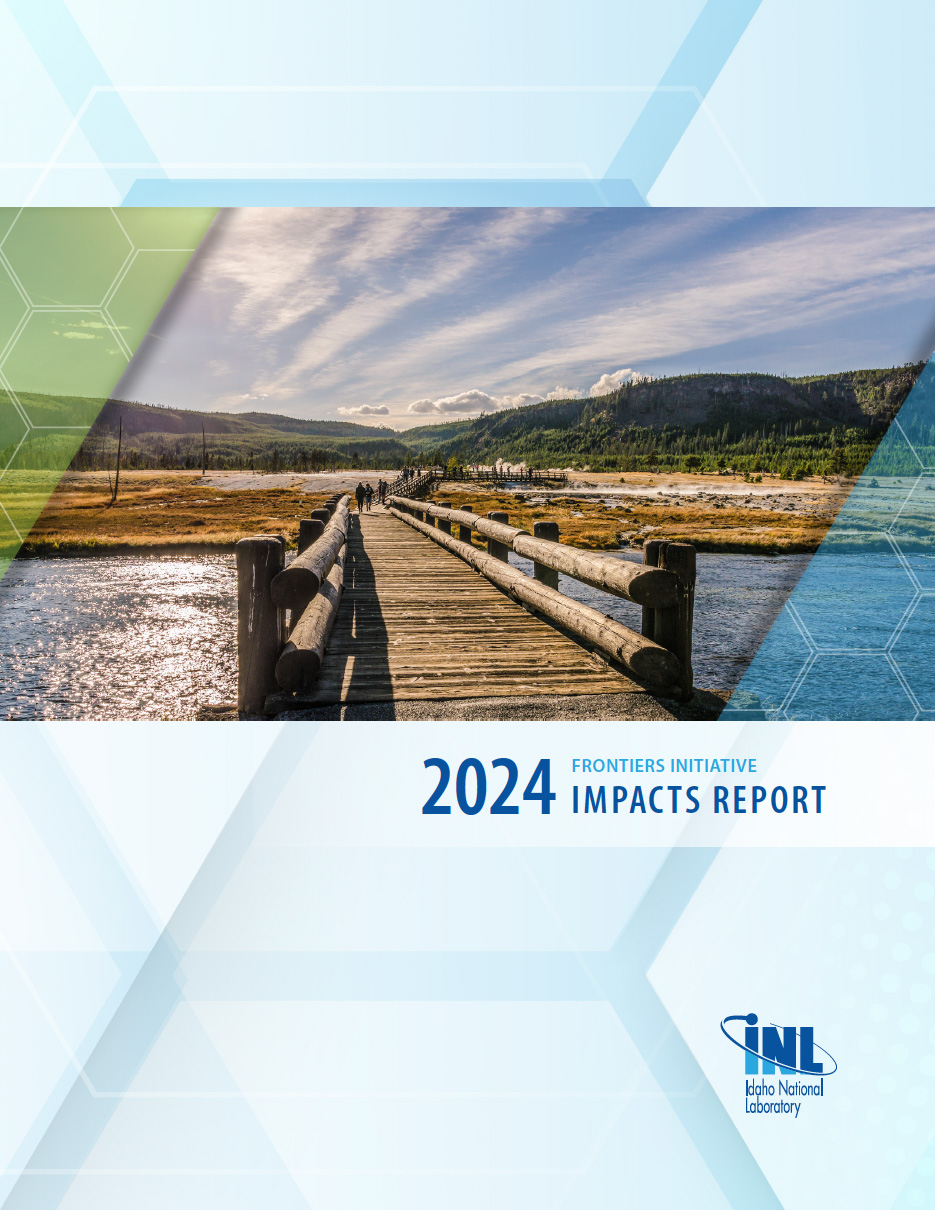Frontiers
Exploring new frontiers in global economic development and competition
Economies around the world are increasingly putting a price on the emissions from their products and activities. Whether through policy and tax actions, business response to consumer demand, or strategic decisions made by capital markets, the cost of carbon emissions tied to products and services will change the global competitive landscape for all industries.
Geopolitical competition is amplifying this competitive shift; and national security implications and interplays based on supply chain security are quickly coming into focus.
Entities that develop and deploy technologies that lower the emissions of their products and services will succeed. These same technologies will have national security applications and implications through common supply chains. Advanced nuclear energy technologies – and novel partnership, business, and regulatory innovation to embed those technologies in commerce – may well be a key to unlock the door to competitiveness that will shift the balance of economic and security competitiveness globally.
The Frontiers Initiative is dedicated to advancing the U.S. position in this new frontier of regional and national security.
News & Resources
Featured Videos
The Frontiers Project Meeting: Baton Rouge, Louisiana
The Louisiana Frontiers Project Meeting looks at the role advanced nuclear energy technologies can play in Louisiana’s manufacturing sector as the state expands its economic production and secures US leadership in the new frontier of global economic competition.
Microreactors: Looking to the past to power the future
More than 60 years ago, U.S. Army researchers and engineers developed a handful of small reactors. Several of these reactors operated reliably for years in some of the harshest environments on earth. Just as tomorrow’s advanced microreactors answer the need for portable, reliable power in the face of climate change, increasing national security risks and a competitive global economy.
The Frontiers Project Meeting: Park City, Utah
This discussion will build on the 2022 and 2023 Frontiers Project Meetings in Jackson, Wyoming, and Anchorage, Alaska, which addressed the economic and energy security imperatives of establishing US leadership in meeting global demand for low-emissions production and manufacturing. The 2024 Frontiers Project Meeting will address Utah’s potential as a first-mover state into advanced nuclear energy technologies, especially for off-grid applications such as data centers, military installations, and mining.
ND Congressman Kelly Armstrong and Dr. Steven Aumeier visit Basin Electric to discuss nuclear energy
Special guest speaker Dr. Steven Aumeier, nuclear engineer and senior advisor for strategic programs at Idaho National Laboratory, recently shared perspectives on the deployment of advanced nuclear energy to the Basin Electric Board of Directors. Dr. Aumeier touched on several topics including the fundamentals of nuclear energy, and the drivers, risks, and opportunities available in the energy sector.
SXSW 2024 DOD Panel discusses critical resources, food, water, minerals and energy
Dr. Steven Aumeier, senior advisor of strategic programs for Idaho National Laboratory, joined an expert lineup led by the U.S. Department of Defense at the SXSW 2024 Conference in Austin, Texas. Steve represented INL’s Frontiers Initiative, dedicated to advancing U.S. economic competitiveness and leadership in energy innovation.
The Future of Wyoming Industrial and Economic Development
Courtesy of the Atlantic Council, this panel from the Frontiers Project in October, 2022 features business, university and economic development leaders across Wyoming as well as TerraPower leadership.
Frequently Asked Questions
What is Frontiers?
Frontiers is about developing regional-to-global strategies that use nuclear energy to compete globally — simultaneously addressing regional energy transitions, energy-driven economic development and environmental justice needs.
What is the focus of Frontiers?
The U.S. is tackling a new frontier of global economic development and competition driven by low-emission energy and industrial reality. Frontiers is focused on how an industry competes in global markets that value (monetize) the emissions associated with products. INL’s role within Frontiers, and other initiatives, is to work with states, regional organizations and communities to help make the transition to low-emissions manufacturing and expand markets for nuclear energy.
What is EMA's role in Frontiers?
The role of EMA is to help entities transition to low-emission based products and services to increase US competitiveness in regional and global markets.
Why are Wyoming, Alaska and Idaho key critical for regional and global transitions?
The role of EMA is to help entities transition to low-emission based products and services to increase US competitiveness in regional and global markets.
How does nuclear energy align with these efforts?
Advanced nuclear is the key that opens the door to global industrial markets that are monetizing low-emissions manufacturing and broader economic activity. New designs are being developed to meet the emerging needs of industry for resilient sources of electricity and heat products, while generating no greenhouse emissions.
What benefits are expected from Frontiers?
Frontiers is a key component of the global transition to low-emission manufacturing driven by climate change and need for domestic, clean energy manufacturing capacity. As the U.S. grid evolves, some regions will adopt low emission energy sources faster than others. Industries choosing to operate in these service territories may improve their domestic and international competitive positions.
How are advanced reactor designs different from traditional / legacy nuclear energy?
Here are the critical differences between traditional nuclear and advanced reactors:
- Safety: Advanced reactors use designs at the cutting edge in nuclear technology that inherently reduce risks and minimize the need for safety-related systems.
- Lower costs: Incorporate factory construction and modularization to lower overall construction and operating costs to be more competitive with other forms of energy generation.
- Industrial decarbonization: Produce not only electricity for the grid, but can also produce clean drinking water, and hydrogen or heat, to decarbonize the industrial and transportation sectors.
- Versatility and flexibility: Have small facility footprints to allow siting near end users, go years between refueling, and easily add units to meet increasing energy needs.
- Increased fuel efficiency: Use fuels that contain more usable energy and result in less long-lived radioactive waste.
What is the state of Micro Reactor Technology?
The visual below captures several of the near-term plans for micro reactor projects in the coming years.


